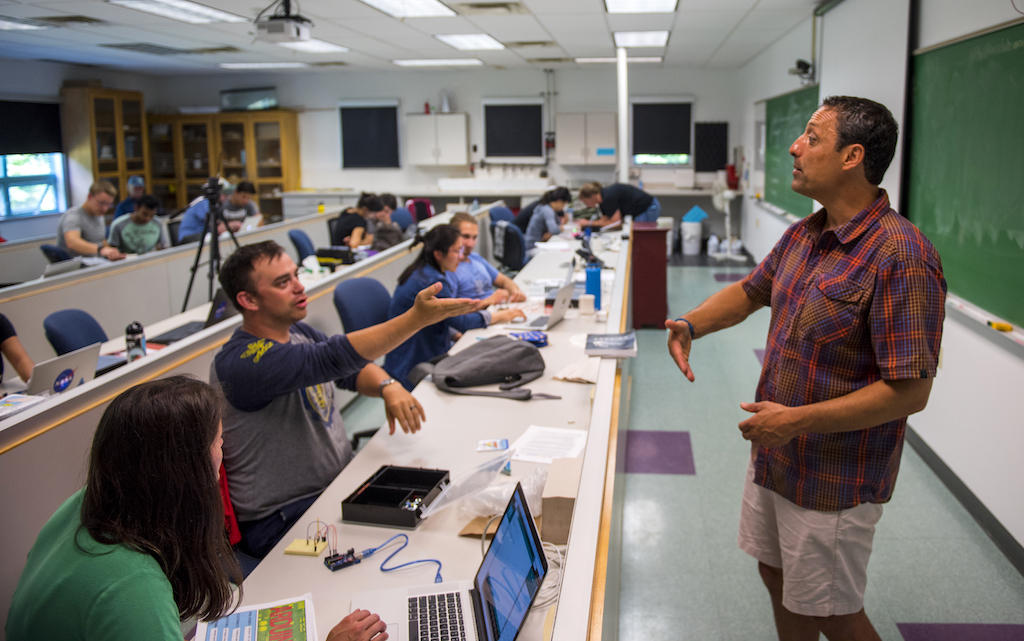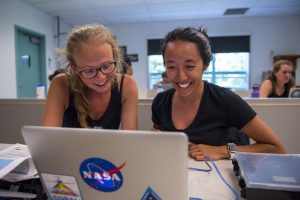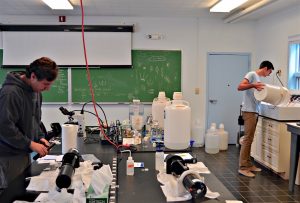
SMS researchers shine a light on the ocean
By Aliya Uteuova
Students and faculty at the University of Maine School of Marine Sciences are among the next generation of oceanographers trained in the use of optical instruments and satellite ocean color remote sensing.
The Darling Marine Center is hosting a four-week ocean optics class on Calibration and Validation for Ocean Color Remote Sensing. Sponsored by NASA and UMaine, the four-week, graduate-level course is offered once every two years. The class started in 1985 at the University of Washington’s Friday Harbor Laboratories. Past students are many of today’s leaders in the field of oceanography.

Ocean optics concerns the study of light and its interaction with materials in the water. By measuring light, scientists can determine where in the water and in what quantities can they find dissolved organic materials, trace metals, sediment particles, and phytoplankton, an important source of food for marine animals.
Students in this class study the ocean remotely using satellites. The satellites measure the amount of light that is reflected and scattered by the ocean, and offer unparalleled coverage of space and time. It is the only method to study the ocean biology daily and on a global scale, with resolution of 30-1,000 meters, depending on the satellite. Scientists verify the satellite data with measurements from various instruments, including spectrophotometer and ACS, a tool that measures attenuation and absorption of different wavelengths of light.
“You can apply optics everywhere where there is water,” Nils Haentjens, teaching assistant for this course, said. “Every particle has a specific light signature. The light can tell what is in the water, if it is more turbid, and if there’s more phytoplankton in the ocean.”

Haentjens took the ocean optics class in 2015. Prior to that, he spent five months sailing around the Mediterranean aboard Tara, a French non-profit research schooner.
“The class allows you to know whether you’re getting good or bad data from the satellite, and how to process that data. It also helps you build a nice network. I am still in contact with most of the students from my class.”
A PhD candidate, Haentjens is working on a NASA-funded project with Emmanuel Boss, the lead instructor of the course. The two met during the 2014 Tara Mediterranean expedition.
Boss took the optics course in 1995. He was a TA for the class in 1998, and an instructor since 2001.
“I believe in this class, it caused me to change my career,” Boss said. “Teaching it is what I need to do to give back to the community.”
A professor of oceanography at UMaine, Boss specializes in marine optics. He is currently leading the science team for the upcoming NASA PACE satellite that will gather critical climate measurements of Earth’s oceans and atmosphere.
“We’ve read their published papers, and now they’re teaching us in person,” Ziwei Wang, a PhD candidate in geography at the University of Victoria, said. “It’s a totally different experience.”
More than one hundred students from all over the world applied to this class. Only twenty of them got in.
The students in this course are exposed to a new level of rigor. They attend lectures in the morning, conduct lab work and learn how to use the instruments in the afternoon, process the data in the evening, read scientific articles at night, and prepare for their group presentations whenever they get a spare minute.
“Usually you retain twenty percent of whatever you learn,” Andre Bucci, a student in the course, said. “But when you go to the lab, when you process the data, work with the instruments and put your hands in this stuff, that’s when it all sinks in.”
This was Bucci’s third time applying for this course. He first applied as a master’s student back in his home country of Brazil, where he conducted research on light absorption by phytoplankton. Bucci is currently pursuing his PhD in oceanography at UMaine. His research revolves around harmful algal blooms, otherwise known as “red tides.”
Phytoplankton dinoflagellate Alexandrium is the common cause of red tides in the Gulf of Maine. The toxin in this phytoplankton causes paralytic shellfish poisoning (PSP).
At certain times of year, Alexandrium is not concentrated enough to pose a threat to human health. However, toxicity can become an issue when the Alexandrium cells bloom. These cells get consumed by filter feeders of the water such as mussels, clams, oysters and scallops.
Coastal shellfish areas are tested for red tide weekly, starting in March through October. When levels of toxicity rise above the set standards, areas are closed to shellfish harvesting, which can lead to economic losses in fisheries.
“If we can track down those water masses by satellite and see exactly where and when Alexandrium is going to bloom, we can make these closures specific in time,” Bucci said.
The field of ocean optics is still very new and niche, most universities do not offer such specific courses. Like Haentjens and Boss, Bucci is building a network of colleagues by taking this class.
“I hope to work with all these guys in the future, publish together and take on new projects,” Bucci said. “You become a small family, a small society that works together until one in the morning.”
“It’s intense,” Lionel Arteaga, ocean biochemist at Princeton University, said. “But it is the class you need to take if you are doing optics because you’re learning from the best scientists in the field.”
Remote sensing provides scientists with global datasets, allowing them to study the ocean at a much bigger scale. With access to both seawater labs and the Damariscotta River, the DMC is an ideal spot for this course. The DMC is looking forward to continue hosting ocean optics classes in the future.
